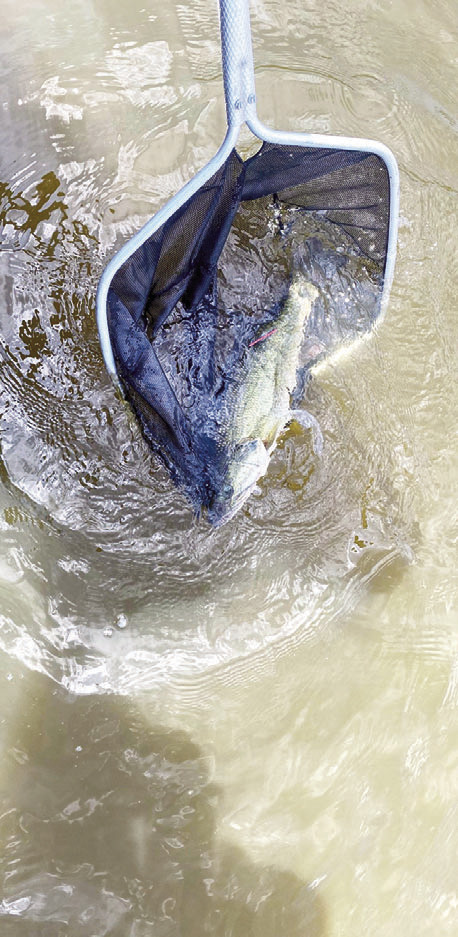TYLER — Biologists from the Texas Parks and Wildlife Department have completed an innovative study that tracked the movement and behaviors of largemouth bass at Toledo Bend Reservoir and Lake Fork. The goal of the multi-year initiative, which launched in 2020, was to learn more about fish behavior and help anglers be more effective when they target largemouth bass.
In 2018, anglers began reporting a decline in catch rates, and many assumed that these declines were attributed to decreased fish populations. Despite reduced catch rates reported in surveys of anglers during 2018-20, the electrofishing data that biologists gathered on fish populations remained consistent. Biologists wanted to explore if increased fishing activity on the lakes had altered the behavior of the fish, which in turn led to a decrease in angler catch rates.
The study at Toledo Bend and Lake Fork focused on seasonal habitat use, the movement and home range of largemouth bass and how it correlated with angling activity. It also explored the effects of boat motor noise and angling activity on fish behavior.
On both lakes, biologists monitored the movement patterns of individual largemouth bass ranging from 16 to 24 inches in length. Biologists implanted radio transmitters into 43 fish at Toledo Bend and 38 fish at Lake Fork to track them over a two-year period.
When the results came in, biologists were intrigued by the movement and home ranges of largemouth bass.
“Some of the biggest surprises were the small home ranges that these fish actually had and how little of an area they occupied throughout the course of a year,” said Jake Norman, Inland Fisheries Division Tyler District Supervisor. “I think most anglers and even biologists, me included, expected to see more seasonal movement especially of individual fish. Overall, we just didn’t see that happen on a larger scale. For example, on Lake Fork, the average total home range these fish occupied was 60 acres or less over the course of the entire study, and the average core use area was just over 10 acres.”
Norman pointed out that the bulk of these fish have home areas and don’t migrate throughout the lake. The time of year didn’t seem to have a big effect on movement and neither did the weather or lake levels.
“There wasn’t a large movement of fish back and forth from the bank to offshore structure,” said Norman. “It highlights that some fish just like to stay in shallow areas and some just like to be more offshore. Fish movement appeared to be the same throughout all four seasons and stable the whole year without a lot of seasonal movement.”
The study also revealed some interesting findings about boat noise and the subsequent reaction by fish when hearing a motor. Biologists indicated that 59 percent of all the relocated fish reacted to boat noise in some capacity.
Norman added that fish size was a relevant indicator for how likely they were to react. They found that fish over 20 inches were more likely to react to boat noise. In addition, fish that were in vegetation reacted more often than when vegetation wasn’t present.
In terms of structure and habitat, the study found that, in general, largemouth bass exhibited habitat preferences.
The results of the study provide insight to anglers on how to target fish and to fisheries biologists in their approach to management.
“A big ‘take home’ of this study is how important it is to be as stealthy as possible when fishing for largemouth bass,” added Norman. “When anglers are sight-fishing and see a fish on a bed, they should do everything they can to make a cast to the fish before it knows they are there. Truthfully, that should be the angler’s mindset throughout all the seasons no matter if they are fishing in a foot of water or 30-plus feet of water. Doing everything you can to be as stealthy as possible will increase your chances of catching the fish you are targeting.”
Overall, when it comes to locations, the traditional target spots proved to be the best when angling for largemouth bass.
“The fish in these studies still selected more of what I call ‘high percentage spots’ like drops, points creeks and other habitat structure,” said Norman. “The places where anglers typically look for to target bass are the areas the fish are still utilizing the most. The study also shows that they are really educated and are very wary when noting an anglers’ presence, which could correlate to the reported lower catch rates.”
The study indicated that fish could also be found in featureless flats — areas that typically had less pressure from anglers. However, in those areas they were more spread out and less concentrated.
The results could also present fisheries managers with two different approaches to habitat installment and enhancement. The first is to concentrate efforts in the high percentage areas, and the second would install more habitat in the flats to help concentrate more fish into a small area around the habitat structures.
One additional impact for biologists could be how surveys are conducted.
“Utilization of shorelines in the fall when we do our electrofishing surveys was very low,” said Norman. “Since these fish weren’t shoreline- oriented in the fall, this is a component of the study for fisheries managers to consider and evaluate when conducting surveys.”
Check out more information on Lake Fork and Toledo Bend Reservoir on the TPWD website. The study was funded by the Sport Fish Restoration Program with matching support from Texas freshwater fishing license funds. The full study can be viewed by visiting the American Fisheries Society website.

Biologists monitored the movement patterns of individual largemouth bass ranging from 16 to 24 inches in length.



